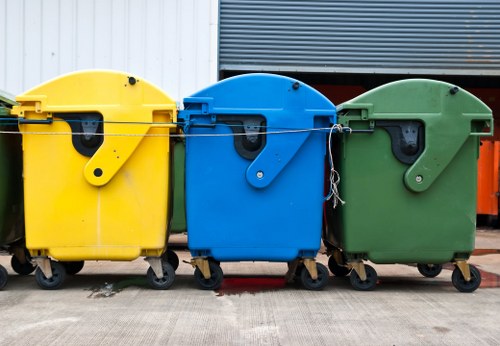Waste Disposal Woodlands: A Comprehensive Guide

Managing waste in woodlands is crucial for environmental preservation and community well-being. Proper waste disposal ensures that our natural landscapes remain pristine and safe for both wildlife and visitors.
Woodlands play a vital role in maintaining ecological balance. They provide habitats for countless species, help in carbon sequestration, and offer recreational spaces for people to enjoy nature.
However, with increased human activity, the challenge of waste disposal in these areas has become more significant. Understanding effective waste management strategies is essential for protecting these valuable ecosystems.

Importance of Waste Disposal in Woodlands
Effective waste disposal in woodlands is not just about keeping the area clean; it’s about safeguarding the environment. Improper waste disposal can lead to pollution, harm to wildlife, and degradation of natural resources.
Environmental Protection: Proper waste disposal prevents litter from contaminating soil and water sources, ensuring that plants and animals remain healthy.
Wildlife Safety: Animals can mistake waste for food, leading to ingestion of harmful materials. Additionally, trapped waste can injure or kill wildlife.

Common Types of Waste in Woodlands
Understanding the types of waste commonly found in woodlands can help in devising effective disposal strategies. The most prevalent types include:
- Plastic waste
- Food scraps
- Glass bottles
- Metal cans
- Organic waste
Each type of waste requires a specific disposal method to minimize its impact on the environment.
For instance, plastics can take hundreds of years to decompose, making recycling a more sustainable option. Conversely, organic waste can be composted to enrich the soil and support plant growth.

Effective Waste Disposal Methods
Implementing effective waste disposal methods in woodlands involves a combination of strategies tailored to the specific environment and types of waste encountered.
Recycling Programs: Establishing recycling stations helps segregate waste, making it easier to recycle materials like plastic, glass, and metal.
Composting: Organic waste can be composted to reduce landfill use and create nutrient-rich soil for the woodland flora.

Community Involvement
Engaging the local community in waste disposal efforts is essential for the long-term success of woodland conservation.
- Educational Programs:
- Community Clean-Up Events
- Volunteer Initiatives
By fostering a sense of responsibility and stewardship, communities can play a significant role in maintaining the cleanliness and health of woodlands.
Furthermore, involving local businesses and schools can amplify the impact of waste disposal initiatives, ensuring a broader reach and more sustainable practices.
Local Areas Near Woodlands for Effective Waste Disposal
Several areas surrounding Woodlands are instrumental in supporting waste disposal efforts. These regions offer additional resources and facilities that enhance the overall management of waste.
- Springfield: Located just 5 miles from Woodlands, Springfield provides advanced recycling facilities.
- Oak Ridge: A neighboring area 7 miles away, Oak Ridge hosts regular community clean-up events.
- Maple Grove: 10 miles from Woodlands, Maple Grove is known for its extensive composting programs.
- Pine Valley: Situated 3 miles from Woodlands, Pine Valley offers specialized waste collection services.
- Cedar Park: Cedar Park, 8 miles away, is recognized for its innovative waste-to-energy initiatives.
- Elmwood: Located 6 miles from Woodlands, Elmwood supports various environmental education programs.
- Birchwood: 4 miles from Woodlands, Birchwood has multiple recycling drop-off points.
- Willow Creek: Willow Creek, 9 miles away, is famous for its volunteer-driven clean-up drives.
- Hemlock Hills: Hemlock Hills, 11 miles from Woodlands, offers eco-friendly waste disposal workshops.
- Aspen Meadows: Aspen Meadows, 12 miles away, boasts state-of-the-art waste management technologies.
Challenges in Waste Disposal Woodlands
Despite the best efforts, waste disposal in woodlands faces several challenges. Addressing these issues is crucial for the effectiveness of waste management strategies.
- Accessibility of Waste Disposal Facilities
- Funding and Resources
- Public Awareness and Participation
- Illegal Dumping
- Environmental Impact
Overcoming these challenges requires a coordinated approach involving local authorities, communities, and environmental organizations.
Accessibility of Waste Disposal Facilities
Ensuring that waste disposal facilities are easily accessible to visitors and residents is essential. Lack of convenient access can lead to increased littering and improper disposal practices.
Solutions:
- Strategic placement of recycling bins throughout the woodland areas.
- Regular maintenance and emptying of disposal units to prevent overflow.
- Providing clear signage to guide visitors to disposal points.
Funding and Resources
Securing adequate funding is a persistent challenge. Waste disposal initiatives require continuous financial support for infrastructure, maintenance, and community programs.
Solutions:
- Applying for government grants and environmental funds.
- Collaborating with local businesses for sponsorship and support.
- Implementing fundraising campaigns within the community.
Innovative Solutions for Waste Disposal Woodlands
Innovation plays a key role in enhancing waste disposal practices in woodlands. Leveraging technology and creative approaches can lead to more efficient and sustainable waste management.
Smart Waste Bins: Equipped with sensors, smart bins can monitor waste levels and notify authorities when they need to be emptied, reducing overflow and maintenance costs.
Eco-friendly Materials: Promoting the use of biodegradable and recyclable materials helps in minimizing waste generation at the source.
Technology Integration
Integrating technology into waste disposal systems can streamline operations and improve efficiency. From mobile apps that guide users to disposal points to automated sorting systems, technology offers numerous benefits.
Examples:
- Mobile apps for locating nearest disposal facilities.
- Automated recycling sorting systems.
- Use of drones for monitoring and managing waste in remote woodland areas.
Community-driven Initiatives
Empowering the community to take part in waste disposal efforts fosters a collective responsibility towards environmental conservation.
Initiatives such as community-based recycling programs, volunteer clean-up groups, and educational workshops can significantly impact the success of waste management in woodlands.
Benefits of Proper Waste Disposal in Woodlands
Implementing effective waste disposal measures in woodlands yields numerous benefits for the environment, wildlife, and the community.
- Enhanced Environmental Health
- Improved Wildlife Safety
- Boosted Community Well-being
- Economic Advantages
- Promotion of Sustainable Practices
Enhanced Environmental Health
Proper waste management reduces pollution levels, ensuring cleaner air, water, and soil. This leads to healthier plant and animal life within the woodlands.
Improved Wildlife Safety
By minimizing litter and hazardous waste, we protect wildlife from potential harm caused by ingestion or entanglement in debris.
Boosted Community Well-being
A clean and well-maintained woodland area provides a pleasant environment for recreation and relaxation, contributing to the overall well-being of the community.
Future of Waste Disposal Woodlands
The future of waste disposal in woodlands lies in sustainable and innovative practices. Emphasizing the use of renewable resources, advanced technologies, and community engagement will pave the way for more effective waste management.
Ongoing research and development in waste management technologies promise to offer new solutions that are both environmentally friendly and cost-effective.
Sustainable Practices
Adopting sustainable practices such as zero-waste policies, circular economy models, and eco-friendly materials can significantly reduce the environmental impact of waste disposal.
Advanced Technologies
Emerging technologies like artificial intelligence, machine learning, and Internet of Things (IoT) can revolutionize waste management by improving efficiency and reducing human intervention.
Community Engagement
Continued community involvement and education are essential for fostering a culture of sustainability and responsibility towards waste disposal.
Conclusion
Waste disposal in woodlands is a critical aspect of environmental conservation. By implementing effective waste management strategies, engaging the community, and leveraging innovative solutions, we can ensure that our woodlands remain healthy and vibrant for generations to come.
Frequently Asked Questions
1. Why is waste disposal important in woodlands?
Proper waste disposal in woodlands prevents pollution, protects wildlife, and maintains the natural beauty and ecological balance of these areas.
2. What are the common types of waste found in woodlands?
The most common types of waste include plastic, food scraps, glass bottles, metal cans, and organic waste.
3. How can communities help in waste disposal efforts?
Communities can participate in clean-up events, support recycling programs, and educate others about the importance of proper waste management.
4. What innovative solutions can improve waste disposal in woodlands?
Innovative solutions include smart waste bins, composting programs, and the integration of technology like mobile apps and automated sorting systems.
5. What are the benefits of proper waste disposal in woodlands?
Benefits include enhanced environmental health, improved wildlife safety, boosted community well-being, economic advantages, and the promotion of sustainable practices.